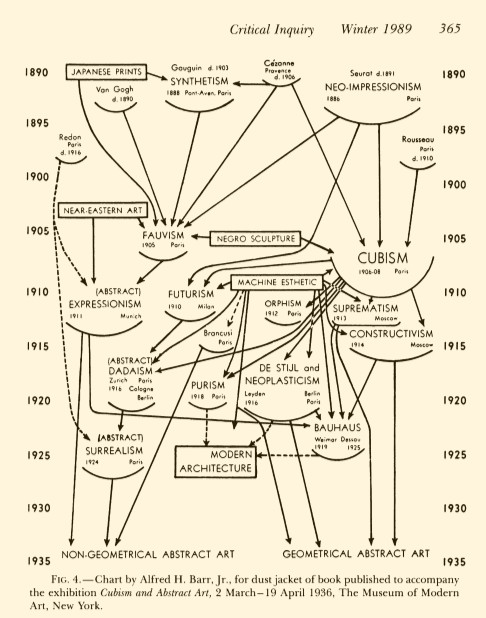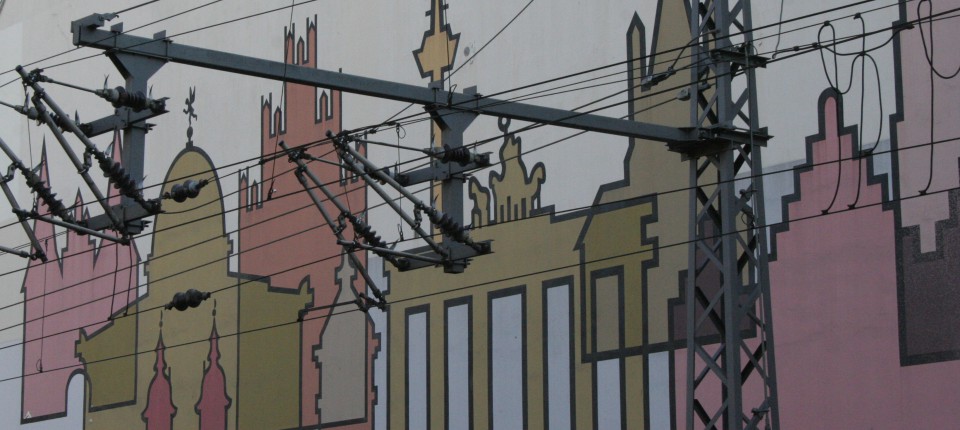Stikkord
Abstract forms, Abstract origin, Alfred H Barr, Geometrical abstract art, non-geometrical abstract art

Fig 1 Chart by Alfred H Barr.jr (1936) illustrates how an abstract art style is influenced by other styles.
The above chart by Alfred H Barr, Jr from 1936 (found in Mitchell 1989, p.365) provides an overview of the different art styles, the connections between them and in which their outcomes become whether non-geometrical or geometrical.
From Barr’s chart one can see that the different styles of abstract art have grown wide since the beginning back in the 1890s. Many of these artists had in common to view the world in an objective and non-egosentric way, which was very much the opposite to how previous art had been expressed. Previously, an artist often created paintings that were copies of nature or a chosen object, interpreted and put together by the only help of each artist’s subjective mind to create his or hers unique expression (Armstrong, 2009). Then combined with this shift in thinking the creation of abstract outcomes became boosted by the possibilities that followed the Machine Age. As it became possible to reproduce both simple forms and typing fonts, part of the artist’s job then turned into be organising these standardised pre-set fonts and forms which were available to construct with the help of the machine. For my annotated bibliography (R&E)I included an interesting text called “Art and Machinery” from 1916 which originally was a letter written to the American artist, writer, publisher, gallery owner and editor of the Soil, Mr. R. J Coady. The sender was named G. Vos, an observer of the aesthetic beauty of the use of the machine in creating art. According to Vos (1916), the use of the Machine would play a great role in changing the outcome of future art.
Many of the artists belonging to these various styles, also produced abstract graphic art
to go along with advertising, packaging design, book and magasine covers. Naturally, they became inspired by what other designers did. For example the way El Lissitzky a Russian Jewish artist who did belong to CONSTRUCTIVISM, influenced BAUHAUS Style packaging design (Arntson, 2012).
Another example how Constructivism did influence the Bauhaus can be seen in this poster created by Bauhaus artist Herbert Bayer in 1923 (see fig 2).

Fig 2 Postcard no. 11 for the Bauhaus exhibition in Weimar, Summer, 1923 by Herbart Bayer.
Another example is artist (musician and painter) Paul Klee, who started as an ABSTRACT EXPRESSIONIST and became later member of the BAUHAUS (Rewald, 2014). His most famous pictures are clearly influenced by CUBISM and Figurism (see fig 2) (Spector n.d).

Fig 3 Red Ballon (1922) by Paul Klee. COPYRIGHT 2014 Artists Rights Society (ARS), New York / VG Bild-Kunst, Bonn
References:
Armstrong, H. (2009). Graphic design theory. New York: Princeton Architectural Press.
Arntson, A. (2012). Graphic design basics. 6th ed. Boston: Carl Baxter.
Mitchell, W. (1989). «Ut Pictura Theoria»: Abstract Painting and the Repression of Language. CRIT INQUIRY, 15(2), p.348.
Vos, G (1916). Art and Machinery. The Soil, 1.1, p 16.
Rewald, S. Paul Klee (1879–1940). In Heilbrunn Timeline of Art History. New York: The Metropolitan Museum of Art, 2004 (Available online at http://www.metmuseum.org/toah/hd/klee/hd_klee.htm) (Accessed on 08.12.2014).
Spector, N Guggenheim -collection online (2000-2014) Available online at http://www.guggenheim.org/new-york/collections/collection-online/artwork/2143 (Accessed on 08.12.2014).
Image sources:
Figure 1 Chart by Alfred H Barr, Jr (1936) [Chart] reprinted in Mitchell, W. (1989). «Ut Pictura Theoria»: Abstract Painting and the Repression of Language. CRIT INQUIRY, 15(2), p.365
Figure 2 Postcard no. 11 (1911) [Colour lithograph on cardboard]. Bauhaus-Archiv Berlin. Photograph: Markus Hawlik. At: http://www.studiointernational.com/index.php/bauhaus-art-as-life (Accessed on 08.12. 2014).
Figure 3 Red Ballon (1922) [oil painting] At: http://www.guggenheim.org/new-york/collections/collection-online/artwork/2143 (Accessed on 08.12.2014).
